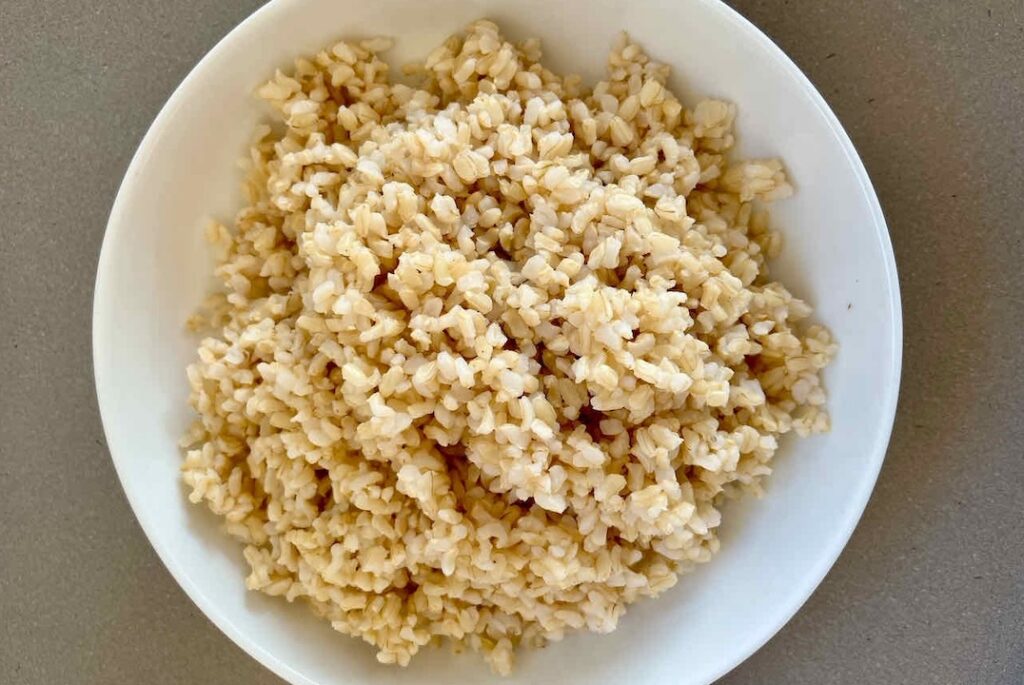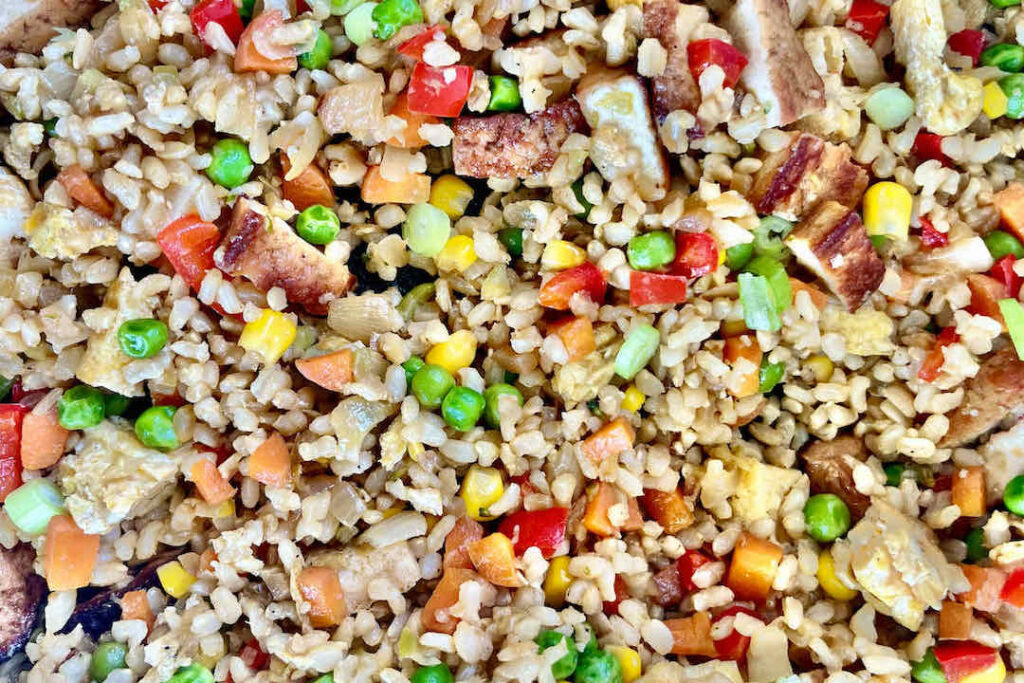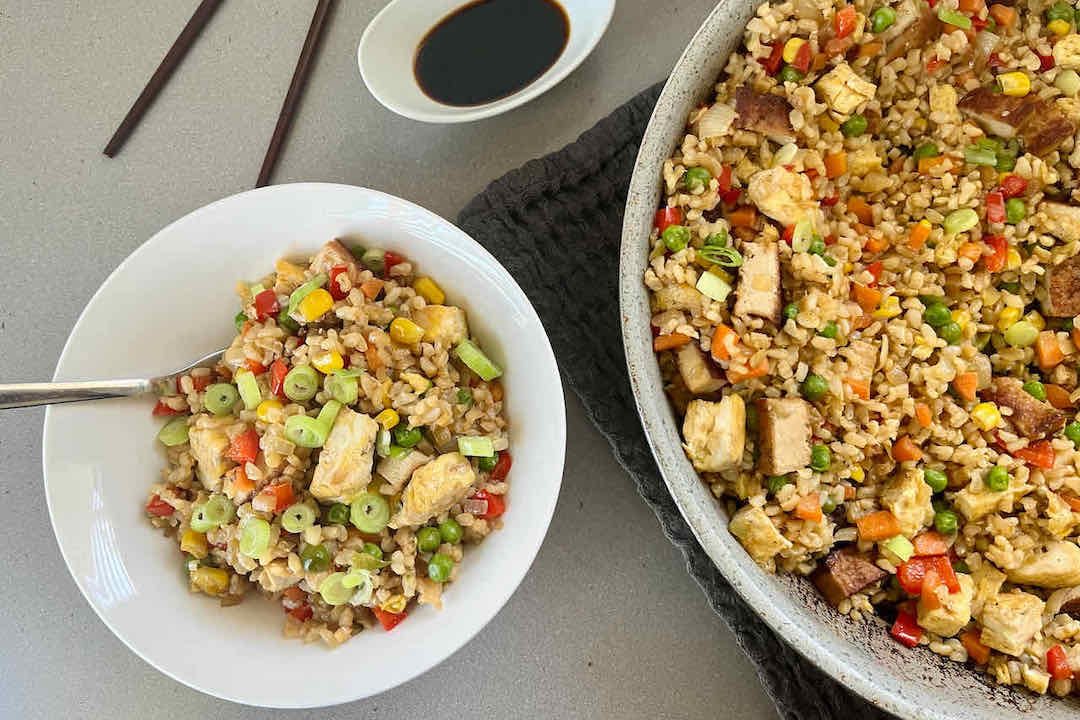This Vegetarian Fried Rice is a tasty and quick family dinner filled with fibre, protein and frozen vegetables. Perfect for the time poor families who don’t want to compromise nutrient quality. In each serve you will get at least two serves of vegetables, protein and low glycemic load carbohydrates from the brown rice and vegetables.

Dietary Suitability of Vegetarian Fried Rice





Vegetarian Fried Rice Food As Medicine

✓ White rice vs brown rice
White rice is simply brown rice with the outer bran and germ removed. This milling process of removing the outer layers means that white rice has less fibre, protein, minerals, B vitamins and antioxidants compared to brown rice. (1) This means for most healthy families without gut sensitivities, brown rice is your best choice for its better nutritional profile.
Although it doesn’t mean you always just have to stick with brown rice. Rotating between brown and white rice and alternatives such as quinoa, barley or cauliflower rice can provide good variety. After all, we know diet variety is a foundational habit for good gut health.
Some kids and adults with gut symptoms or sensitivities may find the higher fibre content and more complex structure of the brown rice harder to tolerate. White rice tends to be broken down quicker with higher amounts of rapidly digestible starch and less slowly digestible starch compared to brown rice. (2) If you or a family member aren’t tolerating brown rice, then white rice may be a better choice. You may even want to try half brown rice and half white rice to understand your personal tolerance and gradually build up your fibre tolerance.

✓ Frozen vegetables
Vegetables fresh from the local farmers markets or straight from the backyard garden are ideal in terms of freshness and reducing food milage. Although there is also a place for frozen vegetables too. Especially for busy households wanting to meet their nutritional needs. Frozen vegetables are convenient to have in the freezer for your end of the week meals or for those nights where you need to make dinner time magic happen quickly.
Choosing frozen vegetables doesn’t have to mean compromising nutritional quality either. Frozen vegetables are frozen immediately after they are picked, locking in most of the nutritional value. You want to choose standard frozen vegetable varieties without sauces and flavours as these will increase your unnecessary sugar and salt intake.
Interestingly a study has shown that frozen fruit and vegetables actually have a better nutritional value compared to vegetables that have been in the fridge for five days. They looked at the concentration of vitamin C, provitamin A and folate in broccoli, cauliflower, corn, green beans, green peas, spinach, blueberries and strawberries and found that after five days of storage there was a negative association with nutrient quality. (3)
Cooking has been shown to impact the nutritional content of frozen vegetables – that is the amount of beneficial vitamins, minerals, phytonutrients and fibre we can obtain from them. Cooking over high heats and for long periods of time have been shown to lead to more nutrient loss. This means steaming and sauteeing in extra virgin olive oil are preferred to boiling over longer periods. Boiling can lead to water soluble vitamins like vitamin C, B vitamins and folate leaching out into the water. While steaming and sauteeing have been shown to be better than boiling, I think the most important thing is to at least get some veggies in. With only about 10% of us adults and less than 1% of our kids meeting our daily vegetable intake, we need to make it achievable for families to eat more vegetables, more often. (4)



Vegetarian Fried Rice
- Author: alanakrahe
- Total Time: 30 minutes
- Yield: 4 serves 1x
Description
This Vegetable Fried Rice is a tasty and quick family dinner filled with fibre, protein and frozen vegetables. Perfect for the time poor families who don’t want to compromise nutrient quality. In each serve you will get at least two serves of vegetables, protein and low glycemic load carbohydrates from the brown rice and vegetables.
Ingredients
- 2 cups of brown rice, cooked and cooled
- Extra virgin olive oil
- 400g tofu, sliced into 1 cm slices
- 4 eggs
- 1 onion, diced
- 2 cloves of garlic, minced
- 1/2 cup frozen peas
- 1/2 cup frozen corn
- 1 carrot, diced
- 1 cup broccoli or frozen broccoli rice
- 3 tbs tamari sauce
- 1/2 tsp sesame oil
- 2 spring onions, thinly sliced
Instructions
- Boil 1.5 cups of brown rice and set aside in the fridge overnight. Alternatively you can skip this step and use a family sized pre-cooked brown rice pouch but just look for no added flavours as you just want 100% rice.
- Pan fry the tofu in extra virgin olive oil and fry on each side until cooked. Remove from the pan, cut into small squares and set aside.
- Whisk four eggs and pour over the base of a hot pan to form an omelette. Cook for about two minutes until cooked and then remove from the pan, slice and set aside.
- Add the onion and garlic to the pan and sautee for a few minutes.
- Add the peas, corn, carrot, broccoli, capsicum, or whatever vegetables you have to add, with some salt and pepper and cook for about five minutes or until the vegetables are cooked.
- Add the brown rice, cooked tofu, tamari and sesame oil and mix through for about three minutes until heated through.
- Then add the cooked egg stir through.
- Top with spring onions, season with salt and pepper if desired and serve.
- Prep Time: 10
- Cook Time: 20

